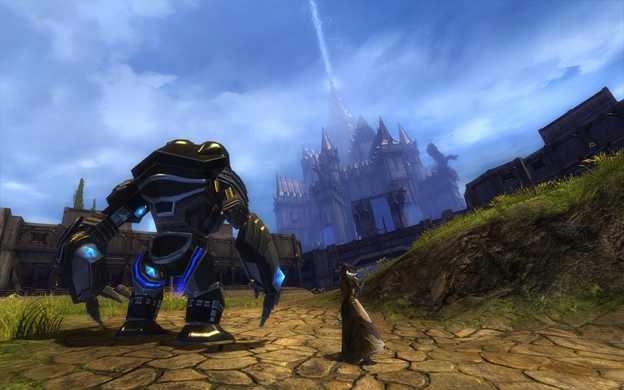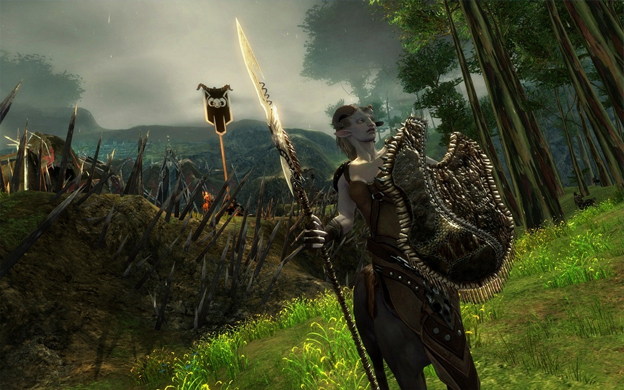WoW, Meet Your Match
Guild Wars and its spinoffs are all well-respected games, but the franchise has never really posed any threat to World of Warcraft, the MMO genre’s king. Developer ArenaNet hopes to change that—and deserves to change that—with Guild Wars 2.
The idea behind Guild Wars 2 is to take everything that’s great about Guild Wars, combine it with everything that’s great about World of Warcraft, and then overhaul everything else. The basic gameplay will be instantly familiar to anyone who’s played an MMO before, with the number-key attacks and the constant search for better gear, but just under the hood there’s a world of difference—from the story and quest lines to the combat and PvP, and all the way down to the business model. This game should shake up the entire industry.

The first time you boot up Guild Wars 2, you go through a user-friendly but surprisingly deep character-creation process. You choose from among five races: the melee-focused Charr; the tiny, magical Asura; the also magical but more balanced Sylvari; the rather bland Humans; and the icy, battle-loving Norn. You also choose a profession (a more specific set of skills to complement your natural talents), and you can customize your avatar to make him look unique.
Perhaps most interestingly, you also choose a variety of biographical details. Throughout the game, the story missions take place in instances, and you view cutscenes—usually just a few characters talking against a hand-drawn backdrop—that are customized to your particular character. It has always been a problem for MMOs that countless people experience the same story together when, for example, every single person is supposed to be a special, hand-picked warrior. Guild Wars 2 manages to make each experience unique, and offers you choices continuously as your story develops.
It’s in between those instances that Guild Wars 2 really shines, however. Oftentimes, you’ll find that your level isn’t high enough to continue the story, so you set about doing side quests in a big, open world. But where any other MMO would have you go to a quest giver, run some errands, and then come back, Guild Wars 2 tries something new.

Outside the story, there are two major types of missions in Guild Wars 2. The first is pretty traditional—you visit a person who needs help and do what they ask in exchange for EXP and gifts. Each quest-giver has only one mission, and you can collect your goodies remotely.
The second, and far more innovative, is called a “dynamic event,” and this is something that happens in the nearby world that requires your attention—there might be a small invasion, or an important person might need an escort. When these events happen, all of the players in the area swarm in to help out. The challenge scales to the number of players who participate, and rewards are distributed according to each person’s contribution. This is ingenious on many levels: It makes the world feel real, it requires cooperation instead of lone-wolf questing, and it avoids the rote repetition of getting quests and checking them off. In addition, the outcome of a dynamic event influences the story; if you fail to keep an invading force out, you might be called on again to repel the bad guys, for example.
The combat is a move forward from World of Warcraft and its ilk as well. Like TERA, Guild Wars 2 is based on the premise that MMO combat can be a little more action and a little less RPG. Sure, there’s still crafting, gear, weapon improvements, and all that jazz. But there’s a dodge button you can use to avoid damage, and you run out of “energy” if you try to abuse it.

Also, each weapon type comes with a certain set of moves, and you unlock the moves by using the weapon rather than buying them from a trainer. You can switch between two sets of weapons instantly. There’s even a “down but not out” mechanic—when your health runs out, you have a brief period to bring yourself back to life by hurling attacks at the enemy that killed you. If you do die, you can either warp to a waypoint or wait for another player to revive you. Each death damages a piece of armor, and if you don’t repair your armor before it’s all damaged, pieces start breaking.
Further, Guild Wars 2 dispenses with the “holy trinity” of tank/DPS/healer. For the most part, each person is in charge of his own healing, and players need to play tank or DPS whenever their class and gear make them best suited for it.
Another major development is in the realm of PvP. Guild Wars 2 still has its predecessor’s arena-style combat, where small teams complete objectives. But there’s also “World vs. World vs. World,” where three teams, each representing a different server, fight battles that last weeks. These contests take place on huge maps with countless objectives scattered across them—towers to control, camps to raid, etc. Players need to work together to accomplish small things, these small things change the tide of battle, and the winning world gets a bonus at the end.
There are tons of other unique features as well. Areas are capped by level, and players who exceed the cap are scaled down—so you can play with your friends on lower-level areas without overpowering them, and you can explore early areas you missed without being bored. There’s a “guest” system that allows you to play with friends on other servers without transferring. When a server gets filled, players are directed to an “overflow” server where they can continue to play and level until the main server is ready. There’s an online market for selling your loot (though unfortunately it wasn’t working well in the days leading up to launch). There’s underwater combat with a separate set of weapons.
The list goes on: Your PvP character has its own gear, and all PvP characters have their levels maxed out, so PvP combat is always based on skill rather than level. Each of the eight dungeons makes an appearance in the story mode—and then flips to exploration mode, where it’s considerably more difficult and gives better loot. Fast travel comes with a small fee in in-game currency, but it’s incredibly useful. Oddly enough, the leveling curve is flat—it won’t take you any longer to go from 79 to 80 than it takes to go from 19 to 20.

Given all of this content and all of this innovation, Guild Wars 2 could be forgiven for a bad launch. But aside from the store being down and some complaints about overflow servers breaking up parties, I noticed very few problems in my days with the game. Not only are glitches rare, but the graphics are beautiful and lush, and the sounds do a fantastic job of bringing out the atmosphere of nature in a fantasy world. There are load times between areas, but they are incredibly short.
To top this, Guild Wars 2 costs $60—and that’s it. There is no subscription fee. And that’s what really ties everything together. Guild Wars 2 doesn’t need to waste your time with quest givers and hiking from place to place and squeezing one extra level out, because the developers don’t need you to keep paying month after month. They want you to think this game is awesome and tell your friends so they buy it too. They don’t want to get you addicted; they want you to enjoy yourself.
Yes, at first blush, Guild Wars 2 seems like World of Warcraft with better graphics. But in countless ways, it’s a complete overhaul of the way things are done. I’ve played a lot of recent MMOs—from Wakfu to SWTOR—and plenty of them were fun and had the potential to grow and improve. But this is the first time I could make the following statement: This MMO, in its current state, poses a serious threat to World of Warcraft.
RATING OUT OF 5 RATING DESCRIPTION 4.7 Graphics
The visuals are a solid step up from the MMO standard. 4.5 Control
There are no surprises here, just basic MMO controls. 4.6 Music / Sound FX / Voice Acting
The voice acting is good, and the sound effects are marvelous. 4.8 Play Value
A full-featured MMO with no subscription fees. 4.7 Overall Rating – Must Buy
Not an average. See Rating legend below for a final score breakdown.
| Review Rating Legend | |||
|---|---|---|---|
| 0.1 – 1.9 = Avoid | 2.5 – 2.9 = Average | 3.5 – 3.9 = Good | 4.5 – 4.9 = Must Buy |
| 2.0 – 2.4 = Poor | 3.0 – 3.4 = Fair | 4.0 – 4.4 = Great | 5.0 = The Best |
Game Features:
